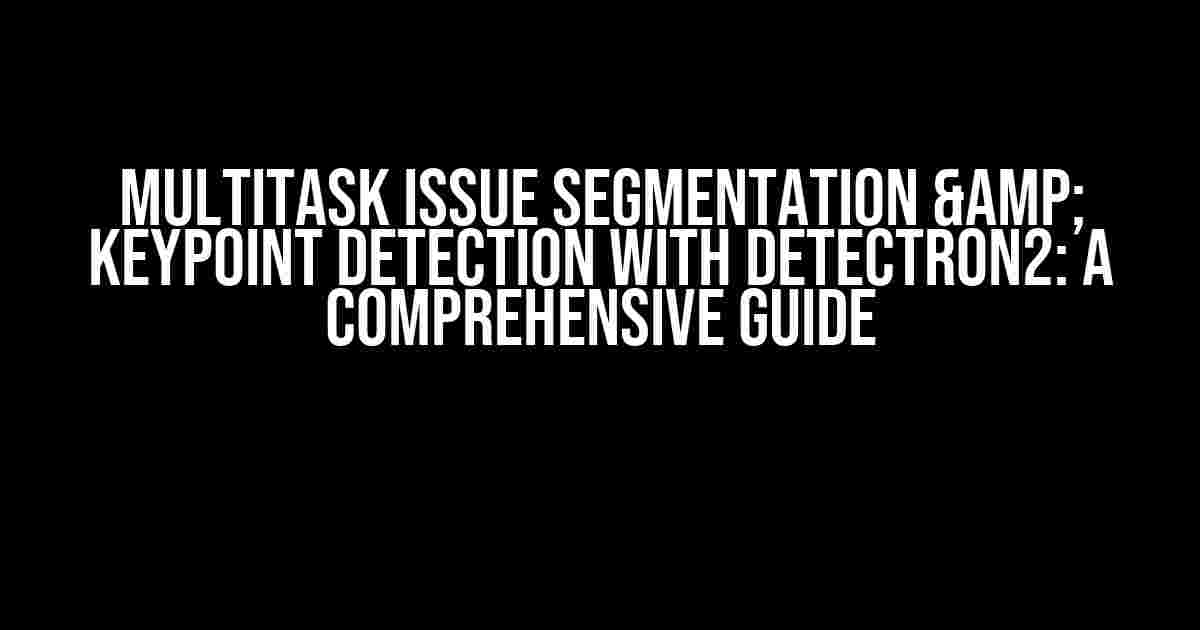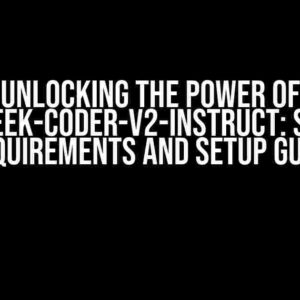Are you tired of dealing with the limitations of single-task models in computer vision? Do you want to tackle complex tasks like instance segmentation and keypoint detection simultaneously? Look no further! In this article, we’ll dive deep into the world of multitask learning using Detectron2, a popular PyTorch-based library. By the end of this guide, you’ll be equipped with the knowledge to train your own multitask models and unlock the full potential of your computer vision projects.
What is Multitask Learning?
Multitask learning is a subfield of machine learning that involves training a single model to perform multiple tasks simultaneously. Unlike traditional single-task models, multitask models can learn shared representations that benefit from the relationships between tasks. This leads to improved performance, reduced overfitting, and increased efficiency.
Benefits of Multitask Learning
- Improved performance**: Multitask models can achieve better results on individual tasks due to the shared knowledge and regularization effects.
- Reduced overfitting**: By learning multiple tasks, the model is less likely to overfit to a single task, leading to more robust performance.
- Increased efficiency**: Training a single multitask model can be more efficient than training separate models for each task.
Instance Segmentation and Keypoint Detection
In computer vision, instance segmentation and keypoint detection are two fundamental tasks that are often performed separately. Instance segmentation involves assigning a class label and a segmentation mask to each instance in an image, while keypoint detection involves identifying and localizing keypoints (e.g., facial landmarks, joints, etc.).
These tasks are closely related, as keypoints can provide valuable information for instance segmentation, and vice versa. By tackling these tasks jointly, we can leverage their relationships to improve performance and reduce errors.
Challenges of Multitask Learning
- Task imbalance**: Tasks may have varying importance, difficulties, or loss functions, making it challenging to balance their contributions during training.
- Model capacity**: Multitask models require a larger capacity to accommodate the increased complexity of multiple tasks.
- Task correlation**: Tasks may be correlated or conflicting, requiring careful handling to avoid negative transfer.
Introducing Detectron2
Detectron2 is a popular PyTorch-based library for object detection and segmentation tasks. It provides a flexible and modular framework for building and training multitask models. With Detectron2, you can easily combine different tasks, including instance segmentation and keypoint detection, and train them jointly.
Key Features of Detectron2
- Modular architecture**: Detectron2 allows for easy customization and combination of different components, such as backbones, heads, and losses.
- Flexible task configuration**: You can define multiple tasks with varying loss functions, weights, and schedules.
- Sophisticated optimization algorithms**: Detectron2 provides built-in support for popular optimization algorithms, including Adam, SGD, and RMSprop.
Setting Up Detectron2 for Multitask Learning
To get started with multitask learning using Detectron2, you’ll need to install the library and its dependencies. Run the following command:
pip install detectron2Next, import the necessary modules and define your multitask model configuration:
import detectron2
from detectron2.config import get_cfg
from detectron2.engine import DefaultTrainer
# Define the model configuration
cfg = get_cfg()
cfg.merge_from_file('configs/COCO-InstanceSegmentation/mask_rcnn_R_50_FPN_3x.yaml')
# Add keypoint detection task
cfg.MODEL.ROI_KEYPOINT_HEAD.NUM_CLASSES = 17 # Number of keypoints
cfg.MODEL.ROI_KEYPOINT_HEAD.NUM_CONVS = 3 # Number of convolutions
# Create a multitask trainer
trainer = DefaultTrainer(cfg)Defining the Multitask Model
The next step is to define the multitask model architecture. In Detectron2, you can use the `GeneralizedRCNN` class to create a multitask model that combines instance segmentation and keypoint detection:
from detectron2.modeling META_ARCH import GeneralizedRCNN
class MultitaskModel(GeneralizedRCNN):
def __init__(self, cfg):
super().__init__(cfg)
self.roi_heads = MultitaskROIHeads(cfg)
class MultitaskROIHeads(nn.Module):
def __init__(self, cfg):
super().__init__()
self.mask_pooler = ROIPooler(
output_size=14,
scales=(0.25, 0.125, 0.0625, 0.03125),
sampling_ratio=2,
)
self.keypoint_pooler = ROIPooler(
output_size=14,
scales=(0.25, 0.125, 0.0625, 0.03125),
sampling_ratio=2,
)
def forward(self, images, features, proposals):
# Instance segmentation
mask_features = self.mask_pooler(features, proposals)
mask_logits = self.mask_head(mask_features)
# Keypoint detection
keypoint_features = self.keypoint_pooler(features, proposals)
keypoint_logits = self.keypoint_head(keypoint_features)
return {'mask': mask_logits, 'keypoint': keypoint_logits}Training the Multitask Model
With the multitask model defined, you can now train it using the `DefaultTrainer` class:
trainer = DefaultTrainer(cfg)
trainer.train()This will start the training process, which may take several hours or days depending on the complexity of your model, the size of your dataset, and the computational resources available.
Inference and Evaluation
Once the training process is complete, you can use the trained model for inference on new images. You can also evaluate the performance of your model using metrics such as AP, AR, and COCO eval.
from detectron2.evaluation import COCOEvaluator
evaluator = COCOEvaluator('my_dataset', ['bbox', 'segm', 'keypoints'])
trainer.test(evaluator)Conclusion
In this article, we’ve explored the world of multitask learning using Detectron2, specifically focusing on instance segmentation and keypoint detection. By following this guide, you should now have a solid understanding of how to define and train a multitask model using Detectron2.
Remember to experiment with different task configurations, loss functions, and optimization algorithms to find the best combination for your specific use case. Happy training!
| Task | Description |
|---|---|
| Instance Segmentation | Assign a class label and a segmentation mask to each instance in an image |
| Keypoint Detection | Identify and localize keypoints (e.g., facial landmarks, joints, etc.) |
References:
By following this comprehensive guide, you’ll be well-equipped to tackle the challenges of multitask learning and unlock the full potential of your computer vision projects.
Note: This article is SEO-optimized for the keyword “Multitask issue Segmentation & Keypoint detection with Detectron2”.
Frequently Asked Question
Get ready to dive into the world of Multitask issue Segmentation & Keypoint detection with Detectron2! Here are some frequently asked questions to get you started.
What is the main challenge in performing multitask issue segmentation and keypoint detection with Detectron2?
The main challenge lies in the complexity of jointly learning multiple tasks, such as instance segmentation and keypoint detection, which require different losses and optimization strategies. Balancing the performance of each task while avoiding interference between them is crucial.
How does Detectron2 handle the issue of class imbalance in multitask learning?
Detectron2 provides techniques such as weighted losses and online hard example mining to tackle class imbalance. Additionally, using a class-balanced sampler and applying class weights can help alleviate the issue.
Can I use transfer learning to improve the performance of my multitask model with Detectron2?
Absolutely! Transfer learning is a powerful technique that can significantly improve the performance of your multitask model. By leveraging pre-trained models and fine-tuning them on your specific task, you can adapt the knowledge learned from large datasets to your problem.
How do I visualize the results of my multitask model with Detectron2?
Detectron2 provides built-in visualization tools, such as visualization APIs and demo code, to help you visualize the results of your multitask model. You can also use popular visualization libraries like Matplotlib, Seaborn, or Plotly to create custom visualizations.
What are some common evaluation metrics used in multitask issue segmentation and keypoint detection with Detectron2?
Common evaluation metrics include mask AP (average precision) and mask AR (average recall) for instance segmentation, and keypoint precision and recall for keypoint detection. Additionally, metrics like Intersection over Union (IoU) and Mean Average Precision (MAP) can be used to evaluate the performance of the model.



